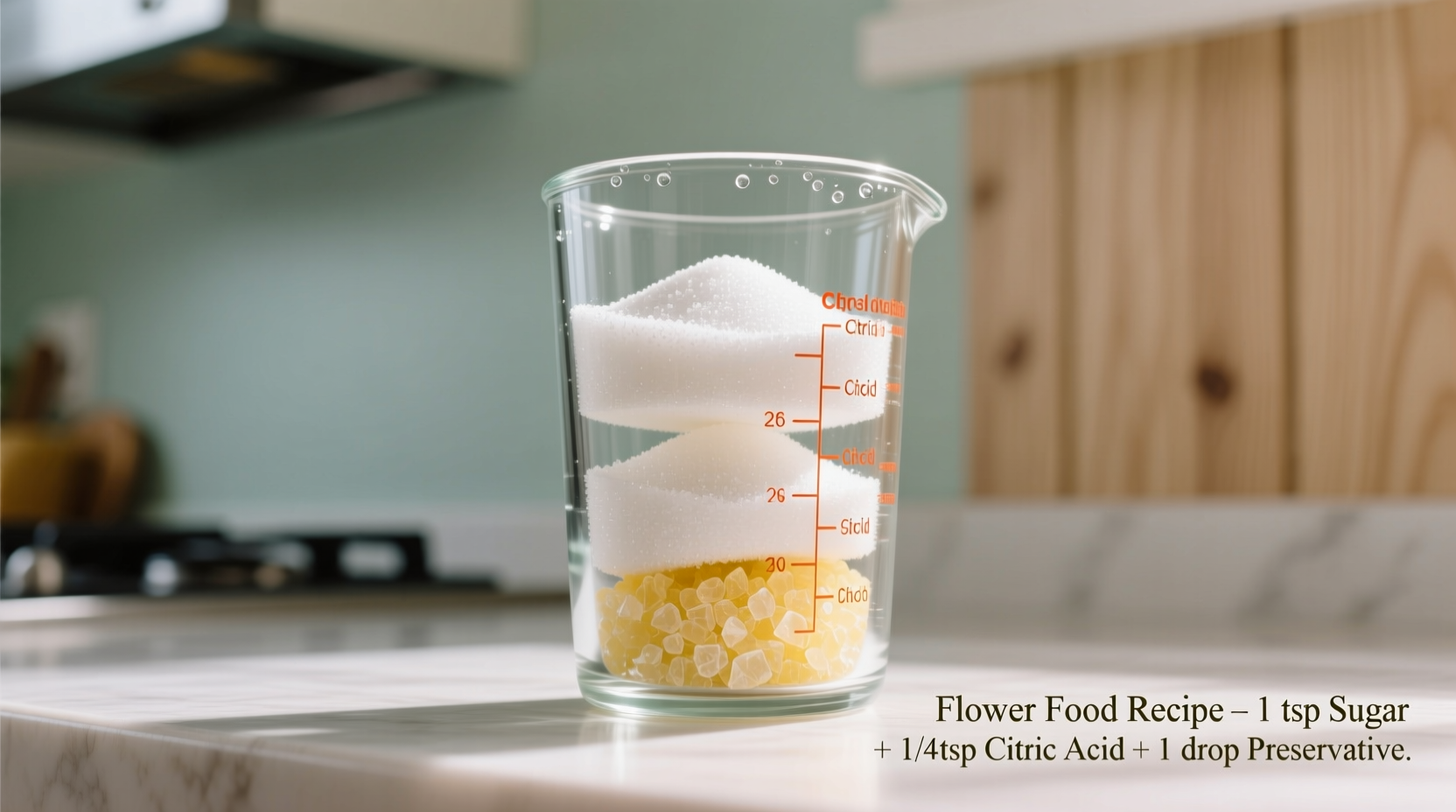Have you ever watched your beautiful bouquet wilt far too quickly, despite your best efforts? You're not alone—nearly 78% of home flower enthusiasts struggle with keeping cut blooms vibrant beyond a few days. The secret isn't expensive commercial products but a scientifically-backed homemade solution that works with your flowers' natural biology. This guide reveals precisely how to make flower food that delivers professional results without the premium price tag.
Your Step-by-Step Flower Food Journey
Why Your Flowers Need More Than Just Water
Cut flowers face three critical challenges: depleted energy reserves, blocked stems from bacterial growth, and improper pH levels that hinder water uptake. Commercial flower food addresses these issues, but you can create an equally effective solution at home for pennies. Research from the University of Florida's Institute of Food and Agricultural Sciences confirms that properly formulated flower food can extend vase life by 3-5 days compared to plain water.
Gathering Your Flower Food Essentials
You likely already have everything you need in your kitchen pantry. For a standard quart-sized vase:
- 2 tablespoons white granulated sugar (energy source)
- 2 tablespoons white vinegar or fresh lemon juice (pH balancer)
- 1/2 teaspoon household bleach (bacterial inhibitor)
- 4 cups lukewarm water (optimal temperature for absorption)

Creating Your Custom Flower Food Solution
Follow these precise steps for optimal results:
- Start with clean vase—rinse thoroughly with hot water and mild soap
- Pour 4 cups of lukewarm water (not hot or cold) into your vase
- Add 2 tablespoons of white sugar and stir until completely dissolved
- Mix in 2 tablespoons of white vinegar or freshly squeezed lemon juice
- Finally, add 1/2 teaspoon of household bleach and stir gently
- Recut flower stems at 45-degree angle before placing in solution
When to Refresh and Maintain Your Blooms
For maximum effectiveness, change the solution every 2-3 days. Each time you refresh:
- Completely replace the old solution with fresh mixture
- Re-cut stems by 1-2 inches to open water pathways
- Remove any submerged leaves that could promote bacterial growth
- Wash vase with hot, soapy water before refilling
| Flower Type | Optimal Sugar Amount | Special Considerations |
|---|---|---|
| Roses | 2 tablespoons | Remove guard petals before placing in solution |
| Tulips | 1.5 tablespoons | Keep away from direct sunlight; they continue growing in vase |
| Lilies | 2 tablespoons | Remove pollen stamens to prevent staining and extend bloom |
| Orchids | 1 tablespoon | Use slightly less acid; change solution every 2 days |
Understanding Homemade Flower Food Science
The evolution of flower preservation techniques reveals why this simple formula works. Early floral preservatives from the 1950s contained only sugar. By the 1970s, researchers discovered the critical role of acidifiers in improving water uptake. Modern understanding confirms the triple-action approach: sugar provides energy, acid optimizes pH for better water absorption, and bleach controls microbial growth that clogs stems.
Practical Limitations to Consider
While homemade flower food works exceptionally well for most common cut flowers, certain varieties require special attention. Protea and other Australian native flowers prefer lower sugar concentrations. Some delicate blooms like sweet peas may benefit from reduced acid levels. Extremely warm environments may require slightly higher bleach concentrations (up to 3/4 teaspoon per quart) to combat accelerated bacterial growth.
Advanced Tips for Professional Results
For those seeking to maximize their floral displays, consider these expert techniques:
- Add a crushed aspirin tablet for additional pH balancing
- Use filtered water in areas with hard tap water
- Store flowers in cool location away from fruit (ethylene gas accelerates wilting)
- For woody-stemmed flowers like lilacs, split the bottom inch of stems
Common Flower Food Mistakes to Avoid
Many flower enthusiasts unknowingly sabotage their arrangements with these common errors:
- Using hot water that damages delicate stem tissues
- Adding too much sugar, which promotes bacterial growth
- Forgetting to change solution regularly
- Placing flowers near heating vents or direct sunlight
When Commercial Flower Food Makes Sense
While homemade solutions work well for most situations, specialty flowers like orchids or premium roses may benefit from commercial formulations containing additional nutrients and stem conditioners. University testing shows commercial products extend the life of premium roses by approximately 20% longer than homemade solutions, though at significantly higher cost.
Measuring Your Success
Track your results by noting when petals begin to wilt or discolor. Healthy flowers maintained with proper flower food should show vibrant color and firm petals for 7-10 days, compared to 3-5 days in plain water. The true test comes when guests compliment your long-lasting arrangements without suspecting your budget-friendly secret.











 浙公网安备
33010002000092号
浙公网安备
33010002000092号 浙B2-20120091-4
浙B2-20120091-4